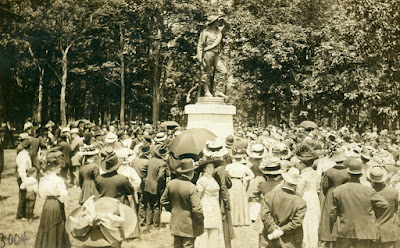John D. Mack and A.C. Blinn founded the Ohio
Structural Iron Company in 1901, after they purchased the Crandall Iron and
Fence Company, located on Warren Street in Sandusky. These advertisements, the one below from
an early issue of Park and Cemetery and
Landscape Gardening, let us know exactly what types of products were made
by the Ohio Structural Iron Company.
In 1903, the Ohio Structural Iron
Company manufactured 200 lawn seats for the parks of the city of Toledo, and
100 lawn seats for the National Soldiers’ Home in Dayton, Ohio. The company built a fire escape
that could fold up like an accordion for the Donahue building in Sandusky in 1905.
After
John D. Mack bought out Mr. Blinn’s interest in the company, he changed the
name to Mack Iron and Wire Works. This company got a contract for building an
iron fence around the Confederate Cemetery at Johnson’s Island, according to an
article which appeared in the September 2, 1912 issue of the Sandusky Register. The fence was four
feet in height and had ornamental posts and arched gates.
A tornado seriously
damaged the Mack Iron and Wire Works building in June of 1924.
In 1925, as the company was re-building, John D. Mack
hired his son-in-law to manage the Iron Works, so he could devote more time to
the Sandusky Register, where he
served as Vice-President and Treasurer. Having weathered setbacks during the
Great Depression, in the 1940s, Mack Iron made defense materials in support of
the U.S. War Effort. So many of Mack’s regular employees went off to serve in
World War II, that to keep up production the company brought in German
prisoners of war from Camp Perry to work on the lines. After the war,
Mack Iron moved from foundry work to metal fabrication. A lengthy article in
the April 22, 2001 issue of the Sandusky
Register reported that projects made by Mack Iron can be seen at Sandusky
City Schools, the Erie County Jail, the County Parking Garage, a coaster at
Cedar Point, and many other area buildings.
You can read more about the history
of Mack Iron Works in the Sandusky
Register of April 22, 2001, now on microfilm at the Sandusky Library Archives
Research Center. The company motto of the Mack Iron Works Company is: “Quality people doing quality work.”
 |
| An aerial view of Mack Iron, taken by photographer Thomas Root in the summer of 1965. |

 this blog
this blog














































